
Exploring Alaskan Malamute Pedigree, Health, and Genetics
Isn’t it fascinating how the Alaskan Malamute, with its impressive strength and remarkable endurance, isn’t just your average four-legged friend? These majestic creatures are living proof of the wonders of careful breeding and the secrets within their genes. When you dive into the world of their ancestry and the DNA that sculpts these proud dogs, keep in mind that each breeding decision ripples through time. It shapes not only their looks but also their health and soul.
Navigating the world of Malamute genetics is like being a detective in a world of puzzles, where every match-up can have lasting effects, well beyond the puppies’ first breaths. Let’s dig into the big questions and the science that’s crucial for keeping this storied breed true to its roots. Together, we’ll uncover how every strand of their DNA is part of a larger story of dog evolution.
Key Takeaways
- Genetic testing is conducted to identify and avoid passing on heritable conditions.
- Well-documented pedigrees highlight desirable traits and commitment to the breed’s health.
- Responsible breeding contributes to the breed’s strength and resilience.
- Pedigree research allows breeders to avoid inbreeding and associated health risks.
Understanding Alaskan Malamute Genetics
Delving into the genetics of Alaskan Malamutes reveals a complex tapestry of traits that define their distinctive appearance and robust health. You might be captivated by the breed’s thick coat, wolf-like features, and powerful frame, but there’s much more to these large dogs than meets the eye. As you explore the world of Alaskan Malamute breeders, you’ll find a commitment to preserving the genetic integrity of the breed.
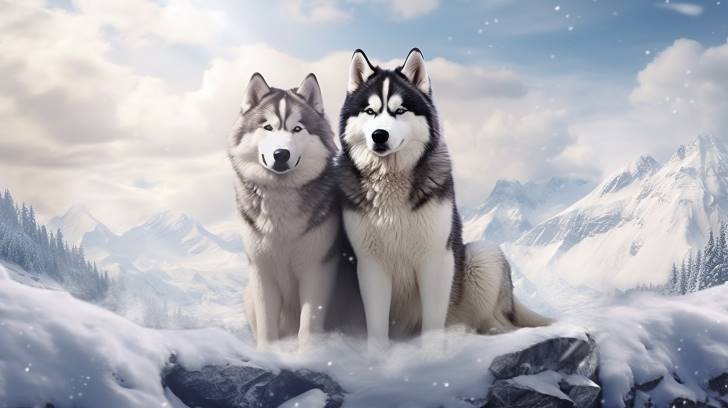
Breeders who affiliate with the AKC (American Kennel Club) typically prioritize the health and lineage of their dogs. When you’re considering an AKC Alaskan Malamute, you’re looking at a dog whose ancestry and breed-specific traits have been carefully documented and maintained. The AKC sets breed standards that ensure each purebred Alaskan Malamute meets specific criteria for appearance, behavior, and other breed-specific traits.
Genetics plays a crucial role in the breed’s overall well-being. Reputable breeders conduct genetic testing to identify and avoid passing on heritable conditions. This proactive approach promotes the longevity and vitality of the breed. As someone interested in the breed’s genetic makeup, you’ll appreciate the rigorous efforts made to minimize health risks.
For instance, a purebred Alaskan Malamute should have a dense double coat, an essential trait for surviving harsh climates. This characteristic, along with others like a strong, muscular build and a friendly temperament, is deeply ingrained in the breed’s genetic code. By choosing a responsibly bred Alaskan Malamute, you’re not only getting a loyal companion but also contributing to the breed’s legacy of strength and resilience.
Understanding the genetics behind these majestic dogs gives you insight into their history and the meticulous care taken to ensure their future. It’s an enlightening journey that connects you to the essence of the Alaskan Malamute.
Importance of Alaskan Malamute Pedigree in Breeding
When choosing an Alaskan Malamute, the pedigree is a crucial factor that provides insight into the dog’s lineage and potential health and behavioral traits. A well-documented pedigree can offer you comprehensive information about your future pet’s ancestors, ensuring that you’re aware of any inheritable conditions that could affect your Malamute’s well-being. It’s essential to engage with the best Alaskan Malamute breeders who prioritize the integrity of the breed’s lineage.
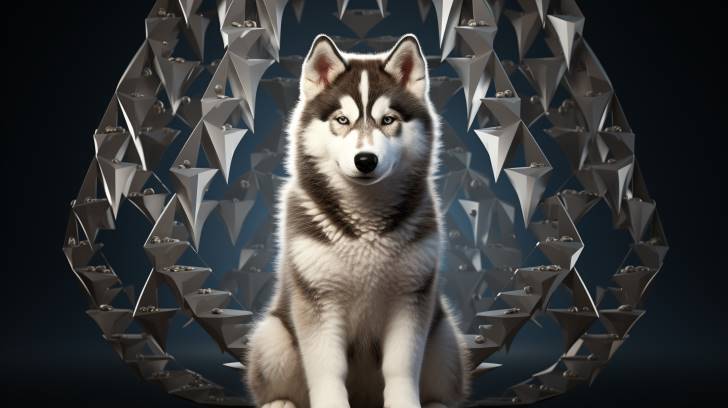
These breeders understand that the Alaskan Malamute is part of a unique genetic tapestry, with its lineage traced back to roles as dependable sled dogs in Arctic conditions. A responsible Alaskan Malamute breeder will provide pedigrees that highlight the dog’s descent from high-performance athletes, showcasing traits like endurance from Malamute and Husky genes, and work ethic potentially influenced by breeds like the Anatolian Shepherd.
The pedigree isn’t just a family tree; it’s a map of genetic potential. It details the careful selection that has led to the Malamute’s current status as a robust and capable breed. In the realm of sled dog racing, data from molecular methods have stratified dogs based on performance phenotypes like speed and endurance. This scientific approach informs breeding decisions, aiming to preserve and enhance these desirable attributes.
As you consider a pedigree, remember that it represents more than past victories in performance—it’s a commitment to the future health and vitality of your companion. Top Alaskan Malamute breeders leverage this information to produce dogs that not only excel in their traditional roles but also thrive as family pets. So, when you’re looking for your next Malamute, make sure to weigh the pedigree heavily in your decision—it’s the blueprint for your dog’s long-term health and happiness.
Origins of Alaskan Malamute Breed History
Understanding the pedigree of an Alaskan Malamute gives you a glimpse into the breed’s storied past, rooted in the history of the Mahlemut, an Inuit tribe whose name these dogs carry. The Alaskan Malamute’s ancestors were vital to the survival of these indigenous people, used for hauling sleds filled with goods across the snow-covered terrain of Alaska. Their powerful appearance, with thick double coats, erect ears, and bushy tails, was matched by their remarkable endurance and fortitude.
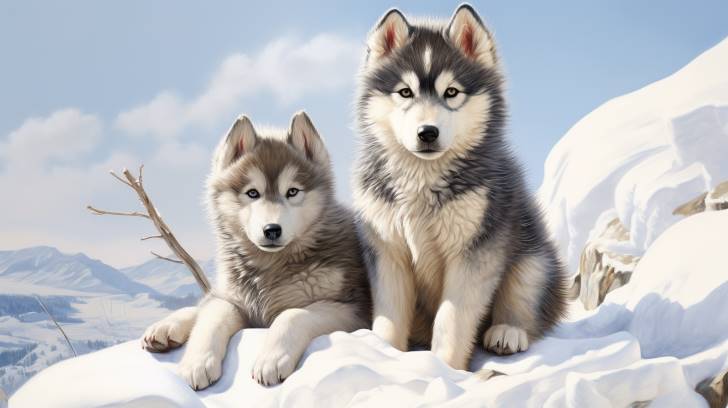
By 1935, the breed was fully recognized by the American Kennel Club (AKC). Today, Alaskan Malamutes are still popular with winter sports enthusiasts, excelling in activities like sledding and weight pulling. They’ve also proven their agility and obedience, adapting to live as cherished family pets even in warmer climates.
Historically, these dogs were not just working animals; they were integral members of the family, playing with small children and sleeping in shelters to provide warmth. Their affectionate and loyal nature likely stems from these close family ties.
However, during the Gold Rush, the breed faced near extinction. The influx of outsiders brought a demand for working dogs, leading to indiscriminate breeding that threatened the Malamute’s lineage. Fortunately, the Mahlemut people’s isolated existence played a crucial role in preserving the breed’s purity.
Malamutes stand out with their distinctive face markings and imposing stature, more powerful and heavier than other Northern breeds. Despite their independent streak, they’re not easily disturbed by strangers, often craving human attention. It’s important to remember their sensitive personalities, as they respond best to gentle handling.
Timeline of Alaskan Malamute Breeding History
Tracing the Alaskan Malamute’s breeding history reveals a timeline marked by both peril and perseverance, starting with the breed’s near extinction during the Gold Rush era. The breed, taking its name from the Mahlemuts, an Inuit tribe in Alaska, faced a dire threat as the demand for working dogs skyrocketed. Dogs from differing breeds were mixed with the native sled dogs, almost wiping out the pure Alaskan Malamute lineage. Fortunately, the Mahlemut people’s isolation played a crucial role in preserving the breed’s integrity.
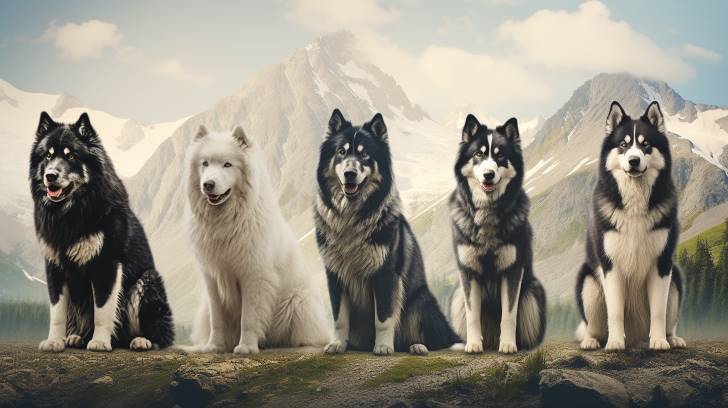
Despite these challenges, Malamutes have not just survived; they’ve thrived. Fully recognized by the American Kennel Club in 1935, these dogs have taken their place not only on the trails and in the show ring but also in the hearts of families, even in warmer climates. They’ve retained their role as powerful working dogs, capable of hauling heavy loads, and still play an active role in activities like sledding and weight pulling.
You’ll find today’s Malamutes remain true to their heritage; they’re more robust and heavier than other Northern breeds. Their affectionate and loyal nature speaks to the close bonds formed with their human families throughout history, often playing with children and keeping everyone warm at night. Though they’re built for endurance, Malamutes possess sensitive souls and demand gentle handling.
Their striking face markings, with a cap over the head or a distinctive bar and mask, and their love for human attention continue to endear them to enthusiasts. However, they maintain a confident and independent streak, which can sometimes lead to tension with other dogs of the same sex.
Through a history fraught with challenges, the Alaskan Malamute dog stands today as a testament to the resilience and unwavering spirit of a breed that has weathered the storms of change.
Genetic Health Concerns for Alaskan Malamutes
Alaskan Malamutes, while known for their resilience and strength, carry a genetic predisposition to certain health concerns that prospective owners should be aware of. As you consider bringing a Malamute into your life, it’s essential to understand these inherited conditions, so you’re prepared to provide the best care possible for your furry companion.
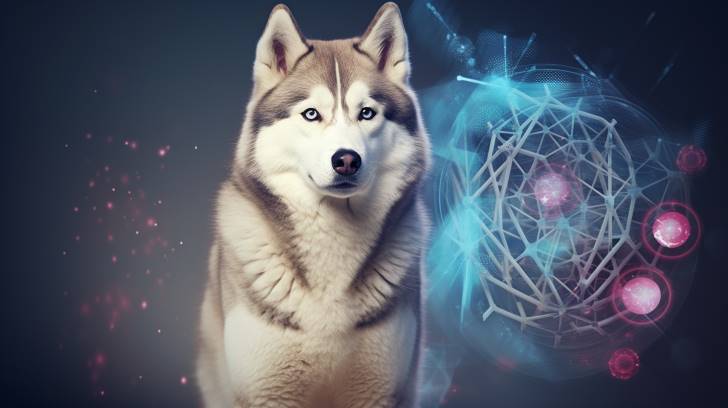
Here are some of the most common genetic health issues found in Alaskan Malamutes:
-
Hip Dysplasia: This condition is characterized by an improperly formed hip joint, which can lead to painful arthritis. Hip dysplasia is prevalent in large breeds, and while it can be managed with medication and care, it’s a lifelong issue that requires attention.
-
Hypothyroidism: Malamutes are prone to this hormonal disorder, which can lead to symptoms like lethargy, weight gain, and coat problems. A daily hormone replacement pill can usually manage the condition effectively.
-
Bloat (Gastric Dilatation and Volvulus): This is a critical condition that affects dogs with deep chests, including Malamutes. Bloat can lead to the stomach twisting on itself, cutting off blood flow. It’s a life-threatening emergency that demands immediate veterinary intervention.
As an owner, you’ll need to be vigilant for any signs of these conditions. Changes in behavior, appetite, or mobility should prompt a visit to the vet. Regular check-ups can help catch issues early, and a balanced diet, regular exercise, and proper grooming go a long way in preventing health problems. Remember, while genetics play a role, your care and attention can greatly influence your Malamute’s overall health and well-being.
Role of Genetics in Alaskan Malamute Temperament
While physical traits in Alaskan Malamutes are easily observed, the breed’s temperament is also deeply rooted in genetics, influencing their behavior and interactions. As you learn about these magnificent dogs, it’s important to recognize that their strong-willed and independent nature isn’t just a result of their upbringing; it’s woven into their DNA.
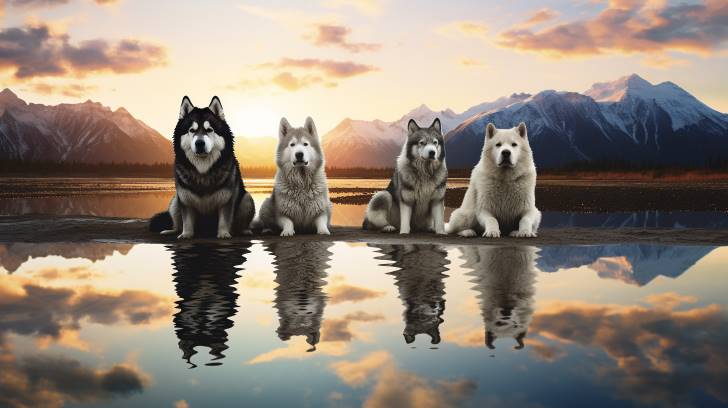
The history of the breed sheds light on their behavior. Originating in the harsh Arctic region, Malamutes were bred to haul heavy loads across frozen landscapes. This required a certain level of endurance, strength, and determination that is still apparent in the breed today. Their ancestors had to be able to work independently and make decisions on their own, which contributed to the Malamute’s independent streak.
Training and socialization are crucial in managing the strong personality traits that come naturally to Malamutes. Their genetic predisposition towards dominance can be mitigated with early and consistent training. If you’re considering owning an Alaskan Malamute, be prepared for a dog that may test boundaries and will require a firm, but loving hand to guide them.
Their playfulness and affectionate demeanor towards family are also traits that are likely influenced by their genetics. Malamutes are known to be loyal and loving to their human companions, displaying a warmth that is characteristic of the breed. However, their genetic makeup may also contribute to less desirable behaviors, such as aggression towards unfamiliar dogs and a propensity to dig or howl when left alone.
Understanding the role of genetics helps you appreciate the entirety of the Alaskan Malamute’s temperament. It’s not just their environment but also their genetic heritage that shapes the unique personality of each dog. With this knowledge, you’re better equipped to provide the right care and training for a well-adjusted and happy Malamute companion.
Finding and Choosing a Reputable Alaskan Malamute Breeder
Embarking on the journey to bring an Alaskan Malamute into your life starts with selecting a breeder who demonstrates a steadfast commitment to the breed’s health and standards. You’re not just looking for a puppy; you’re seeking a lifelong companion that embodies the breed’s majestic qualities and robust health.
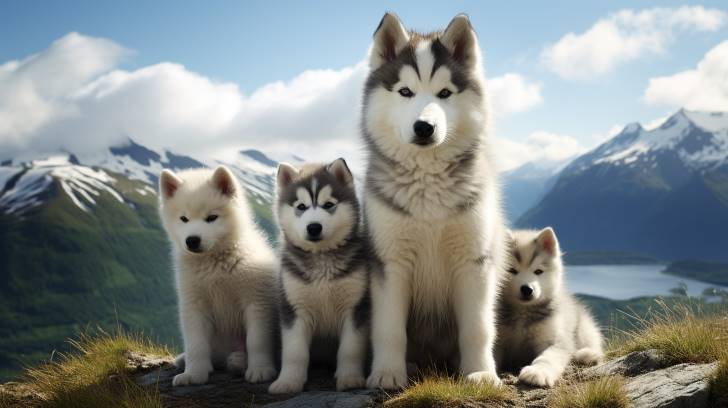
To ensure you’re choosing a breeder who prioritizes the betterment of the breed, here’s what you need to consider:
- Research and Recommendations:
- Begin with national and local Alaskan Malamute clubs for a list of reputable breeders.
- Join dedicated Facebook groups and inquire about others’ experiences with breeders.
- Network with Malamute owners to learn firsthand about their breeders’ practices.
- Breeder’s Commitment:
- Look for breeders who specialize in Malamutes rather than multiple breeds, ensuring a deeper understanding of the breed’s specific needs.
- Confirm that the breeder engages their dogs in working activities and dog shows, demonstrating a commitment to maintaining the breed’s working heritage and conformation standards.
- Choose breeders who plan a limited number of litters, are club members, and who conduct thorough health checks on their dogs, including OFA certifications for hips, eyes, and more.
- Aftercare and Ethics:
- Ensure the breeder offers ongoing support and has a clear policy in place to take back any dog they’ve produced if necessary.
- Be wary of breeders who always have puppies available or use manipulative sales tactics.
- Reputable breeders will match a puppy to your lifestyle, emphasizing the importance of temperament and energy level compatibility.
Finding a Reputable Alaskan Malamute Breeder
To ensure your future Malamute’s health and happiness, it’s crucial to find a breeder whose practices are as robust and majestic as the breed itself. You want to choose someone who prioritizes the well-being of their dogs and is dedicated to the breed’s preservation.
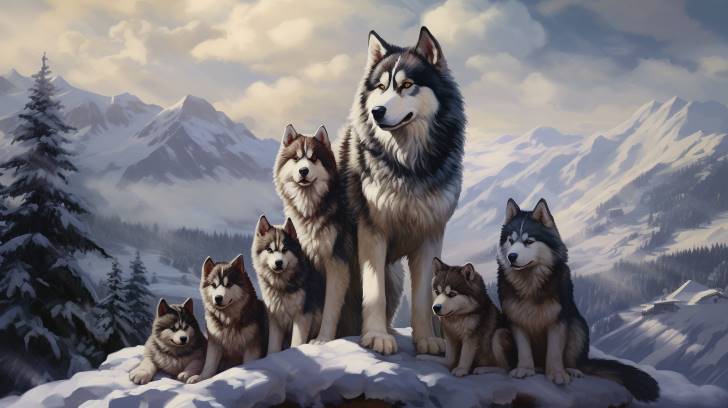
When searching for a breeder, look for those who register their litters with recognized clubs like the AKC and who provide comprehensive health tests for the parents. A health guarantee for the puppies is also a sign of a responsible breeder. They should be willing to discuss their breeding practices with you and show a genuine interest in finding suitable homes for their puppies.
Be wary of red flags that indicate a breeder may not have the dogs’ best interests at heart. Avoid breeders who request payments online or exploit the breed by advertising “rare” colors at a premium price. These practices can detract from the health and standard of the breed.
Here’s a quick reference table to help you differentiate between reputable and questionable breeders:
| Reputable Breeder | Questionable Practices | Unethical Breeder |
|---|---|---|
| Health tests for parents | Advertises rare colors | Breeds 5+ litters from one female |
| AKC registered litters | Online payments for puppies | Lacks knowledge in training |
| Offers health guarantees | Sells puppies with breeding rights | Prioritizes profit over well-being |
Understanding Alaskan Malamute Breeding Cycle
Having selected a reputable breeder, it’s essential to understand the Alaskan Malamute’s breeding cycle to ensure the timing is right for breeding and to provide optimal care for your dog. Grasping the nuances of this cycle will help you recognize when your female Malamute is ready to mate and allow you to create the best environment for her during this time.
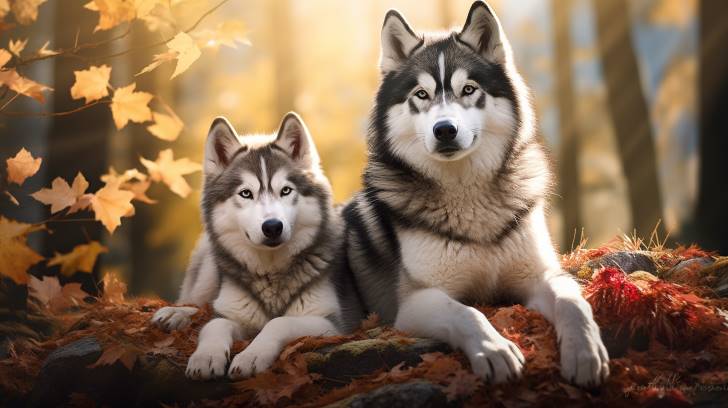
Your Malamute will experience her first heat anywhere from 6 to 12 months of age, and it’ll repeat every 6-12 months throughout her life. The heat cycle is a complex process with four distinct phases:
-
Proestrus Phase: This phase signals the upcoming fertility period. You’ll notice your Malamute’s external reproductive organs swelling and a blood-tinged discharge. She might lick her genital area more than usual and could exhibit clingy behavior or aggression toward male dogs.
-
Estrus Phase: The main mating phase. The vaginal discharge lessens and changes color, while your dog may urinate more frequently, signaling her readiness to mate. This is when she’ll actively seek out male dogs, often approaching them with a flagged tail to indicate her willingness to breed.
-
Diestrus and Anestrus Phases: Post the main mating phase, the Diestrus phase occurs; your dog’s body either returns to normal or she begins pregnancy. The Anestrus phase is a period of sexual and hormonal inactivity, setting the stage for the next cycle.
It’s important to track her heat cycle, not only for breeding but also to provide her with the care she needs. During her heat, keep her environment calm, limit her exercise, and consider using dog diapers to manage the discharge. Always consult with your vet before making decisions about spaying, which can prevent unwanted litters and might be beneficial for her health. Understanding your Malamute’s breeding cycle is crucial for responsible breeding and her wellbeing.
Choosing a Alaskan Malamute Breeder
When selecting an Alaskan Malamute breeder, it’s crucial to evaluate their practices and commitment to the breed’s health and temperament. You’ll want to find someone who conducts interviews to determine if you’re a good match for the breed. They should ask about your living conditions, like if you have a fenced yard, and show a genuine interest in where their puppies are going.
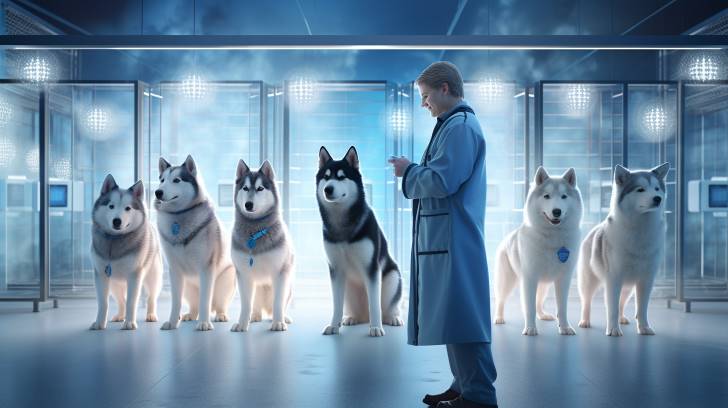
Ensure the breeder uses a detailed contract that clearly outlines responsibilities on both sides. Steer clear of breeders who don’t use contracts or offer only vague agreements. A specific contract is your safeguard against potential health problems, and be wary of any that only guarantees health if you return the dog.
It’s essential to visit the breeder’s facilities. The environment should be clean, and the puppies need to be alert and well-socialized. A reputable breeder will guide you in choosing a puppy and be upfront about the challenges each puppy may present.
The breeder should be ready to provide support even after the sale. They should be willing to take back the dog if needed and offer help with training and grooming. Don’t hesitate to ask for references to verify their ongoing support.
Understanding the Breeder’s Approach to Genetic Health Concerns
A responsible Alaskan Malamute breeder prioritizes genetic health by carefully selecting mating pairs to minimize the risk of hereditary conditions. They understand that a successful breeding program involves more than just matching male and female dogs; it’s about preserving the breed’s qualities while ensuring the health and vitality of each litter.
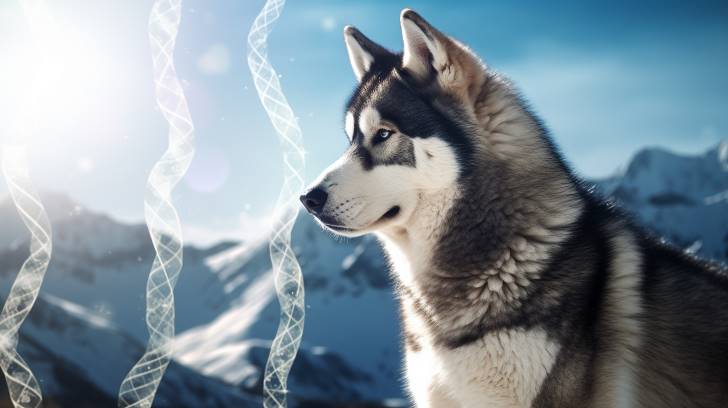
To achieve this, breeders take a strategic approach:
-
Linebreeding and Outcrossing: They often engage in linebreeding, which is a form of inbreeding that brings out recessive genes in a controlled manner, enhancing desired traits without compromising genetic diversity. Linebreeding is meticulously planned and executed over generations. However, when the gene pool becomes too narrow, breeders will outcross, pairing dogs with less closely related genetics to inject new vitality into the line. This helps avoid inbreeding depression—a decline in health and vigor due to overly similar genetics.
-
Understanding Dominant and Recessive Traits: By knowing which traits are dominant or recessive and how they interact, breeders can predict the likelihood of certain characteristics appearing in their litters. This knowledge is crucial to avoid inadvertently doubling up on harmful recessive genes that could lead to genetic disorders.
-
Genetic Testing and Health Screening: With advancements in genetic testing, breeders can now identify carriers of specific hereditary conditions. Health screening of breeding candidates is a non-negotiable aspect of a responsible breeder’s routine, ensuring they’re not passing on preventable diseases.
Ethics and Best Practices in Breeding
In breeding Alaskan Malamutes, it’s essential to adhere to ethical standards and best practices to ensure the health and well-being of the dogs. You must understand the various breeding methods, including inbreeding, linebreeding, outcrossing, and crossbreeding, and the genetic principles that govern them. Each method has its place, but your primary focus should be on the animals’ health, temperament, and conformity to breed standards.
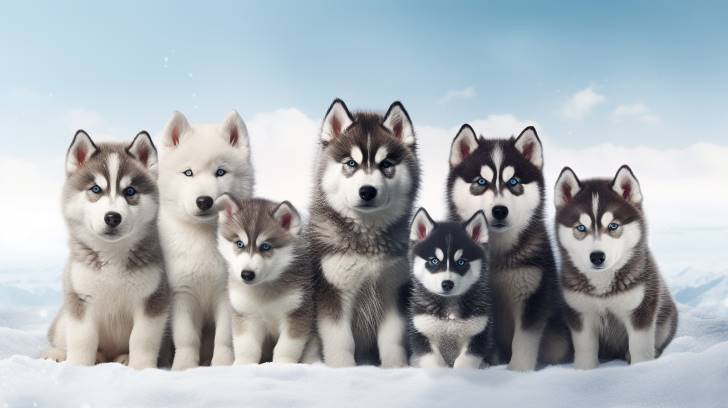
When considering inbreeding, remember it brings out recessive genes, which can be both good and bad. You’re dealing with a double-edged sword that can either improve the breed or bring to light harmful genetic conditions. Therefore, inbreeding should be approached with caution and used alongside careful selection to ensure breed improvement. Linebreeding, a milder form of inbreeding, requires a well-thought-out program tailored to the specific case to achieve the desired traits in a controlled manner.
Outcrossing is your tool for introducing new genetic diversity and avoiding inbreeding depression. It’s important to ensure that the dogs you’re mating are less closely related and that a four-generation pedigree shows no common ancestors. Hybrid vigor, a potential benefit of outcrossing, can result in superior offspring but isn’t guaranteed. Your selection process must be meticulous to maintain true breed characteristics.
Crossbreeding is generally not recommended for Alaskan Malamutes, as it may dilute breed-specific traits, especially when mixed with non-arctic dogs. Focus instead on linebreeding and strategic outcrossing or inbreeding to refine desirable traits and minimize the less desirable ones. Always plan future breedings based on the results you observe in the growing puppies, and adjust your strategies accordingly. Your ethical compass should guide you toward practices that prioritize the well-being of the Alaskan Malamute breed above all else.
Role of Genetics in Alaskan Malamute Temperament
While understanding breeding methods is crucial for maintaining the physical health of Alaskan Malamutes, it’s equally important to recognize how genetics influence their temperament. Genes play a significant role in shaping a dog’s behavior, and this is particularly true for a breed as distinctive as the Alaskan Malamute.
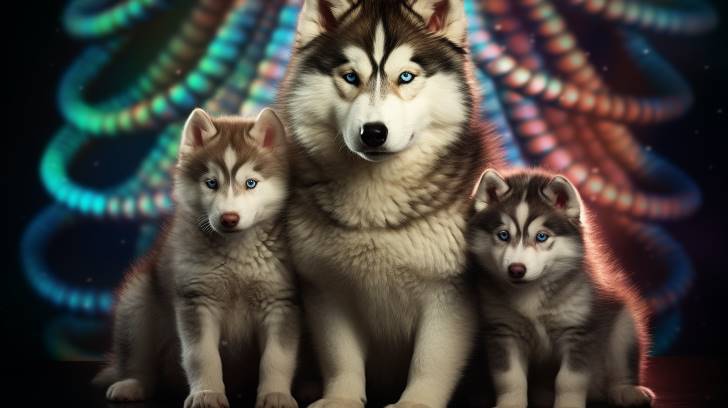
When considering the genetic factors that contribute to temperament, you need to bear in mind:
-
Dominant and Recessive Traits: These traits can affect a Malamute’s disposition. For instance, a recessive gene may result in a more subdued character if it becomes homozygous due to inbreeding. Conversely, dominant traits might lead to more assertive behaviors.
-
Linebreeding and Outcrossing Effects: Strategic linebreeding can help reinforce desirable temperamental traits, but it’s a double-edged sword as it can also cement unwanted behaviors. Outcrossing, on the other hand, can introduce new behavioral traits and increase genetic diversity, which might enhance the overall temperament.
-
Hybrid Vigor: Occasionally, outcrossing can result in hybrid vigor, which could lead to offspring with improved temperament as well as health. However, this isn’t a guaranteed outcome and requires meticulous planning and knowledge of the gene pool.
Ethical Considerations in Alaskan Malamute Breeding
Breeding Alaskan Malamutes ethically requires a deep understanding of the potential impact each decision has on the breed’s future. When you consider inbreeding, it’s crucial to remember that it can bring out recessive genes, which may affect the health and well-being of the dogs. Although inbreeding can improve the breed when accompanied by careful selection, you must be aware of the genetic history to avoid potential health issues.
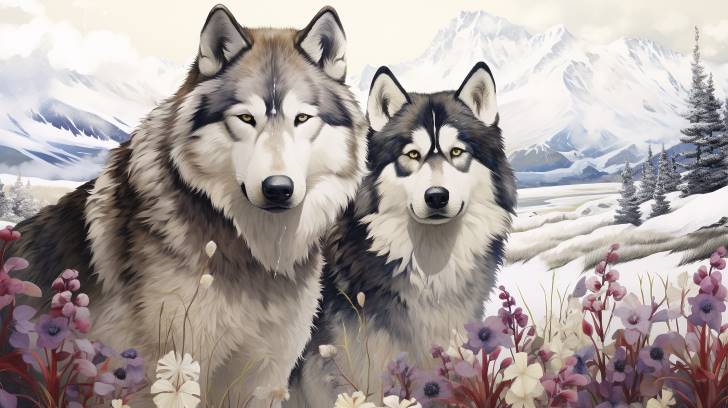
Linebreeding is a form of inbreeding you might use to maintain specific traits, but it requires meticulous planning unique to each situation. It’s less about following a general rule and more about understanding the intricate gene interactions within your dogs. Meanwhile, outcrossing introduces new genetic diversity, which can enhance vigor and health. But don’t forget, outcrossing should be done with no common ancestors in a four-generation pedigree to prevent inadvertent inbreeding.
Hybrid vigor, often a result of outcrossing, can produce superior offspring, but predicting its occurrence is tricky. The advantages can diminish over time, so continuous evaluation and planning are necessary. Remember, outcrossing’s value in dog breeding, particularly for Alaskan Malamutes, is subject to debate but can yield excellent results.
Crossbreeding with non-arctic dogs, however, isn’t a viable strategy for Alaskan Malamutes; it risks losing the breed’s unique arctic traits. As a breeder, you must prioritize the preservation and improvement of the breed’s characteristics, steering clear of crossbreeding except for specific, well-justified research purposes.
Ultimately, your goal should be to refine the desired traits and minimize the undesirable ones through a strategic combination of linebreeding, outcrossing, and occasional inbreeding, always keeping the breed’s best interests at heart. Ethical breeding isn’t just about following plans; it’s about making informed, responsible decisions for the future of the Alaskan Malamutes.
Importance of Pedigree in Alaskan Malamute Breeding
Understanding the pedigree of an Alaskan Malamute is crucial for any breeder aiming to maintain the breed’s integrity and health. As you delve into the world of breeding these magnificent dogs, you’re not just looking at the immediate parents, but at generations of lineage that inform each pup’s potential. A well-documented pedigree gives you a roadmap to the genetic history, revealing patterns that could affect the future of your breeding program.
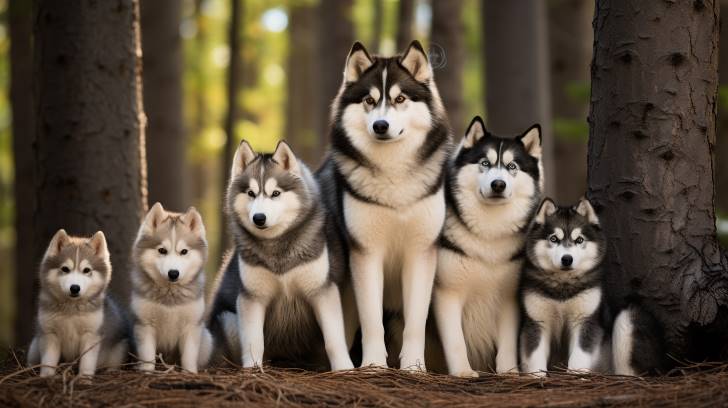
When considering a pedigree, here’s what you need to keep in mind:
-
Genetic Health: A pedigree can highlight the inheritance of both desirable traits and potential genetic health issues. Knowing the history enables you to avoid inbreeding and the associated health risks, while also aiming to reinforce strong, positive traits through linebreeding and outcrossing.
-
Breed Standards: You’re committed to preserving the Alaskan Malamute’s unique characteristics. A thorough pedigree analysis ensures that you’re maintaining the breed standard, which includes physical attributes and temperament, by selecting individuals that best represent these qualities.
-
Breeding Strategy: By understanding the genetic makeup of your dogs, you can strategically plan breedings to refine desired traits and minimize less desirable ones. A pedigree is an invaluable tool for this, guiding decisions on linebreeding, outcrossing, or even the occasional inbreeding when trying to fix certain characteristics.
Pedigrees are more than just certificates; they’re the heritage and future of the Alaskan Malamute breed. They’re your guide to responsible breeding, allowing you to create a lineage of dogs that not only look the part but are healthy, strong, and well-adapted to their intended roles. So, always prioritize pedigree research—it’s the cornerstone of any successful breeding endeavor.
Best Practices for Maintaining Breed Standards
Having established the importance of pedigree in Alaskan Malamute breeding, let’s now focus on the best practices for ensuring these dogs meet established breed standards. The key is to balance genetic diversity with the retention of the breed’s unique characteristics.
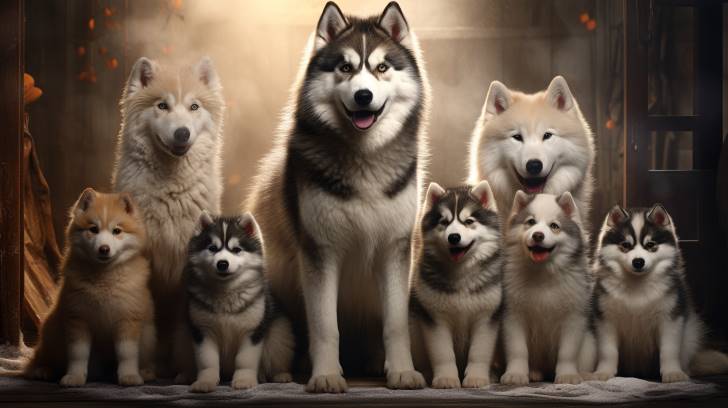
Start by selecting breeding pairs with a clear understanding of dominant and recessive traits. This knowledge allows you to foresee potential outcomes and avoid undesirable traits. Linebreeding, while a form of inbreeding, can be used strategically to maintain breed standards. However, you must be cautious and avoid excessive inbreeding, as it can bring out harmful recessive genes.
Occasional outcrossing is beneficial to introduce new genetic material into your breeding line, which can improve health and vigor. But remember, careful selection in outcrossing is crucial to ensure that the breed’s standards are not compromised.
Here’s a concise guide to the breeding methods and their impact on maintaining breed standards:
| Breeding Method | Goal | Consideration |
|---|---|---|
| Inbreeding | Bring out recessive traits | Monitor for genetic defects |
| Linebreeding | Maintain traits orderly | Base on quality stock |
| Outcrossing | Increase genetic diversity | Choose unrelated pairs wisely |
| Crossbreeding | Not recommended for purebreds | Can dilute breed characteristics |
In linebreeding and breeding strategies, focus on refining desired traits and minimizing the undesirable ones. Always evaluate the outcomes of your breeding program as puppies grow, and plan future breedings with these considerations in mind. While hybrid vigor from outcrossing can be beneficial, its predictability is challenging, so breed with care.
Conclusion
Navigating the world of Alaskan Malamute genetics and breeding has been quite the journey, right? From their rich history to the importance of their family tree, we’ve covered a lot. Now you’ve got a handle on the health issues these awesome dogs might face and how their genes shape their cool personalities.
Here’s the deal: when it comes to breeding these magnificent pups, doing the right thing is key. It’s not just about looking good. Nope, it’s about keeping them healthy and full of life. Every time a Malamute puppy is born, we’ve got to think about their future. Let’s make sure we’re doing our best for them, every single time.
Frequently Asked Questions
How Does Climate or Environment Affect Alaskan Malamute Breeding Practices, and Are There Special Considerations for Breeders in Warmer Regions?
You’re wondering how surroundings impact breeding practices, right? In warmer areas, you’ve got to be extra careful. Heat can stress the dogs out, so you need to ensure they stay cool. That means providing lots of shade and water, maybe even air conditioning. You’ll also have to adjust exercise routines to avoid the hottest parts of the day. It’s all about keeping the pups healthy and comfortable, no matter the thermometer reading.
Can Alaskan Malamutes Be Crossbred With Other Breeds, and if So, What Are Common Outcomes or Considerations in Terms of Health and Temperament?
You can crossbreed Alaskan Malamutes with other dog breeds, leading to mixed offspring with varied traits. Commonly, you’ll find these mixes might have different temperaments or health issues, depending on their genetic mix. You’ll need to consider each parent’s characteristics carefully. It’s essential to research and prepare for any inherited conditions that could arise, ensuring you’re ready to provide the best care for a potentially unique and energetic companion.
How Do Alaskan Malamute Breeding Strategies Vary Across Different Countries or Cultures, and What Unique Breeding Practices Might Exist Outside of the United States?
You’re exploring how dog breeding strategies differ globally, and it’s fascinating to see the unique practices employed outside the US. Some countries prioritize working abilities, while others may focus on preserving breed standards or enhancing certain traits. It’s crucial to be aware of these variations as they reflect local values and can significantly impact the dogs’ health and behavior. Always consider these factors when discussing or engaging in breeding practices.
What Are Some Contemporary Debates or Controversies Within the Alaskan Malamute Breeding Community That Prospective Breeders Should Be Aware Of?
You should be aware that in the breeding community, there’s heated debate over issues like genetic diversity, the ethics of breeding for certain physical traits, and the preservation of the breed’s working dog heritage. Some argue that show standards can lead to health problems, while others focus on maintaining breed purity. It’s crucial to navigate these controversies responsibly to ensure the well-being of the dogs and the integrity of the breed.
How Do Advancements in Canine Genetic Testing Impact the Future of Alaskan Malamute Breeding, and Are There Any New Genetic Markers or Traits That Breeders Are Starting to Select For?
Advancements in genetic testing are revolutionizing the way you’ll breed dogs, pinpointing hereditary conditions, and shaping healthier future generations. Breeders are now selecting for new genetic markers, reducing the incidence of genetic diseases. You’ll be able to tailor breeding programs with greater precision, ensuring pups inherit the best traits while minimizing health risks, ultimately leading to a brighter future for the breed you love.

